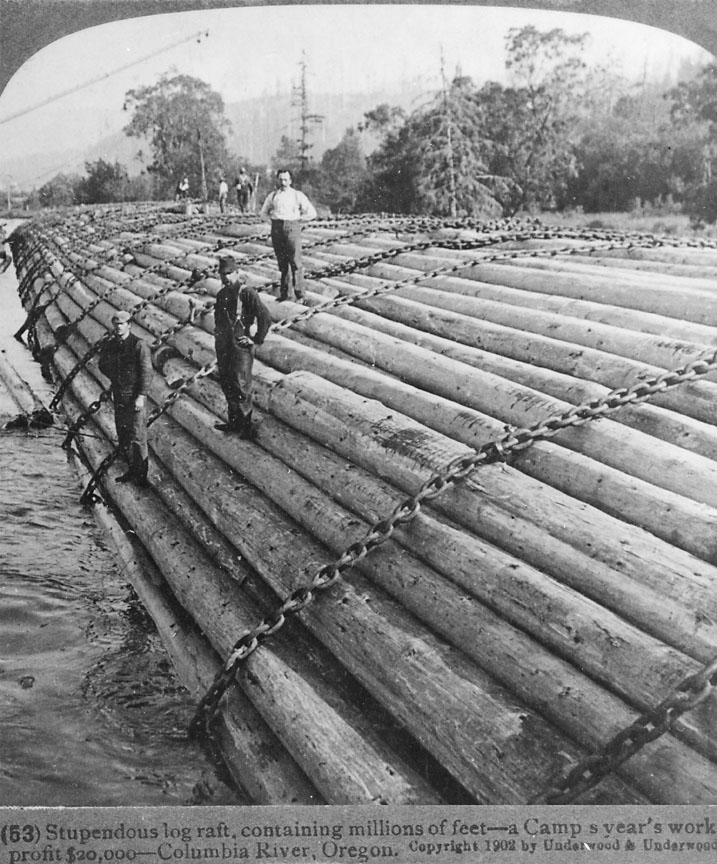- Catalog No. —
- CN 018169
- Date —
- 1902 (1906)
- Era —
- 1881-1920 (Industrialization and Progressive Reform)
- Themes —
- Arts, Trade, Business, Industry, and the Economy, Transportation and Communication
- Credits —
- Oregon Historical Society
- Regions —
- Columbia River
- Author —
- Underwood & Underwood
Log Rafts, 1902
This photograph of men posing atop a “Benson raft” was originally sold as a stereograph by Underwood & Underwood, a stereographic distributing company, established in 1882. Stereographic cards contained two identical images side by side and were looked at through special spectacles, creating a three-dimensional effect for viewers. According to the accompanying text, the photograph dates to 1902. However, the photograph is likely misdated, since rafts of this size were not yet built until 1906. Log rafts like the one pictured here were first developed in 1906 by Simon Benson, a Portland-based timber magnate. Although Benson was not the first timberman to transport his company’s logs to market by rafting them together, he was the first to develop an ocean-worthy raft that could dependably transport “millions of feet” at a time.
Determined to find a way to profit from the high demand for lumber in the booming city of San Diego, California, Benson developed his log rafts so that he could circumvent the high costs of railroad and/or ocean barge transportation along the Pacific Coast. After working out his own design, he hired John A. Festabend to supervise construction of the cigar-shaped rafts, which were assembled in the calm waters of the Wallace Slough, near Clatskanie.
Raft construction began with the building of a floating wooden “cradle,” which slightly resembled the wooden frame of a large sailing ship. A floating derrick then lifted logs into the cradle over a period of four to seven weeks. Although logs of all sizes were transported, a large volume of tree-length logs were included in the raft to give it strength and stability in its voyage across the Columbia River bar and in the open ocean. Enormous chains were also used to lash the raft together, with one running lengthwise through the center, some encircling the raft approximately every fifteen to twenty feet, and still more attaching the chains to each other at strategic points throughout the raft.
When a raft was complete, one side of the cradle was removed and the raft was “kicked out.” Once free-floating, rafts would “flatten out” in the water, further tightening the circle chains and making them even stronger. Most rafts hauled approximately 4 to 6 million feet of logs and were typically about 800 to 1000 feet long, 55 feet wide, and 35 feet thick from top to bottom—usually drafting 26 to 28 feet deep. Holding them together was anywhere from 175 to 250 tons of chain.
Benson’s rafts were transported the 1,100 miles to San Diego during the summer, arriving at his saw mill roughly 15 days after leaving Clatskanie. The rafts were a huge success. Between 1906 and 1941, 120 Benson rafts were sent to San Diego from the Columbia River, with only 4 being lost by ocean storm or fire. More than half the time, the rafts were “deck loaded” with processed lumber like shingles, fence posts, poles and spurs to maximize profits. Even so, Simon Benson quickly outgrew the business venture and sold all of his holdings in Clatskanie and San Diego between 1909 and 1911.
Further Reading:
Evenson, W. R. “Benson Rafts: Giant Wood Piles Afloat.” Merchant 60 (1981): 40, 42, 66–67.
Allen, Alice Benson. Simon Benson: Northwest Lumber King. Portland, Oreg., 1971.
Written by Joshua Binus, © Oregon Historical Society, 2004
